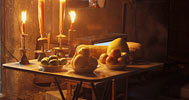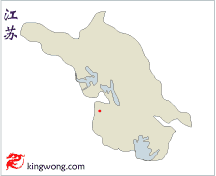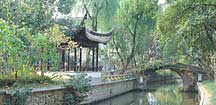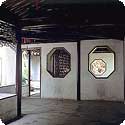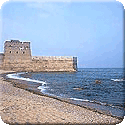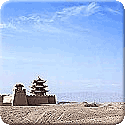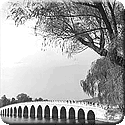Region: 江苏Jiangsu
南京六朝石刻图片Nanjing's Six Dynasties Stone Beasts Pictures
-
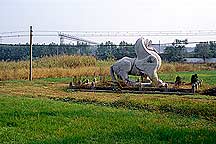
This spirit path to commemorate the son of the Liang ruler Liang Wudi's uncle who died in the year 523 consist of a stone lion and a memorial stela. Originally there were two lions, the other one had been prreviously dugged-up but was irrepairable so it went back down. This one measures 305 meters high and 3.8 meters long.
-
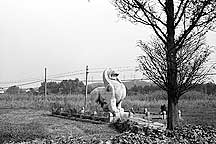
-
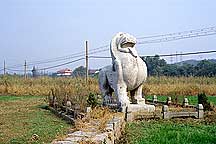
-
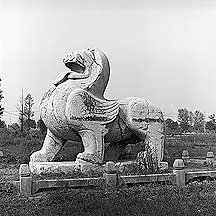
The lion's pair of wings betrays a very non-chinese mentality. Chinese animals or mythical creatures do not need wings to fly, unless it is a bird or an animal that naturally possess wings. This is also true of immortals. While western mystical animals(such as Pagasus or a unicorn), Biblical angels(Michelangelo is exception) in general, and modern western superheroes(such as superman with his cape) requires the necessary anatomy (or a symbol such as the cape) or an external force such is propulsion in order to fly, Chinese equivalents glide through space without them. Generally speaking, this is in part due to the Chinese sense of space and time being moral(that is, mental) while that of the west is material( that is, visual).
-
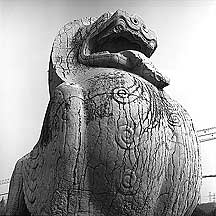
The sculptural conception of this stone lion is the interplay of simple forms and dramatic details. Major parts of the lion(such as the mane, the body, and the legs) are condensed to large stylized shapes, while focused areas(such as the teeth, the claws, and the wings) are vividly detailed.
-
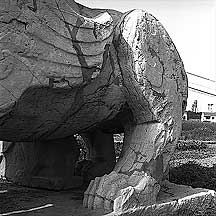
The legs had been supporting the massive body for a millennium and a half.
-
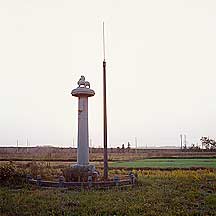
This stela is just across the road from the previous lion. It measures 6.5 meters high and its base circle is 2.48 meter in diameter.
-
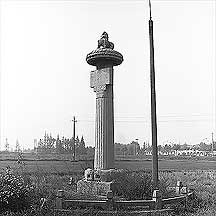
-
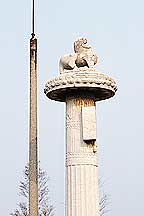
The little stone lion perch on a Buddhist lotus pedal. The pieces were created during the time when Buddhism was at one of its peaks. Many of the sinicised rulers were devout Buddhists.
-
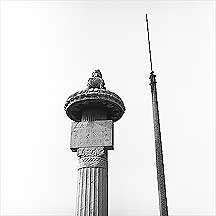
-
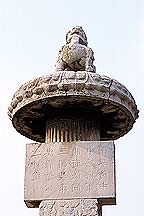
The small lion is about .8 meters high and long. Below the lotus is a restangular stone block with 23 carved chinese characters that are mirrored(for ink-rubbing?).
-
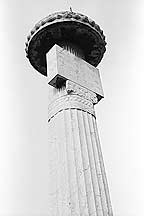
-
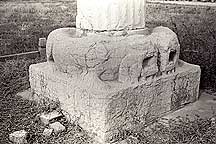
On the base of the column are two beasts(tigers?) facing one another. The carving has lost much of its detail, and I could not make out what it represents.
-
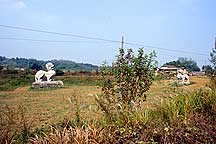
My hired motor tricycle had to go through rough narrow dirt and gravel paths to get to these two pieces. Starting from the main road, it took about a half hour of twist and turns. These simple vehicles are popular in the countryside as well as in smaller cities. They are small and slow, which made them very suitable for the rough and curvy paths here. Unfortunately they lack a suspension system, so I felt like riding on Han war chariot drawn by two horses. The two qilins form the spirit path to the tomb of the 陈朝Chen Dynasty ruler 陈文帝 Chen Wendi(527-566). Before the two qilins were stone slab identifying them. Not far from this slab was a shelter with a couple of cows in it. It was nice to hear the mooing while I was shooting and wandering around. The nearby dog soon joined in with its barking as well. There was no crops on the soft ground, but it appeared to be slightly tilled.
-
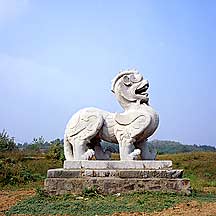
One of the two qilins. Both are male. This one has two horns, the other, one horn. The Qilin is the most venerated of the four noble beasts which include the Phoenix(not an accurate translation as it is not the same Greek bird), the Tortoise, and the Dragon.
-
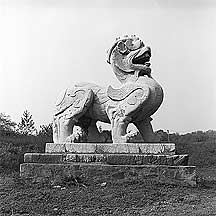
Qilin is a Chinase mythical animal that were mentioned early in ancients texts such as the Book of Songs, Zhou Nan, Book of Rites, and others. Its appearance signifies the coming of an exceptional figure(such as the during the birth of Confucious) or a phenomenal change. The traditional description of a qilin is that it is a yellow beast with a body of a deer, the legs of a horse, the paws of a wolf, the tail of a cow, and one horn(or two horns). The Western unicorn, which qilin is often translated as, has a head of a horse, the hind legs of a stag, the tail of a lion, and a single horn in the middle of the forehead( from Webster's Dictionary). The qilins in this farm don't exactly fit the description. They look more like lions with unusual heads.
-
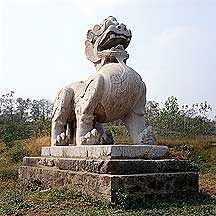
-
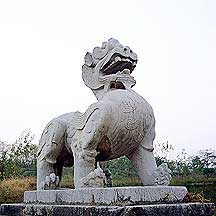
-
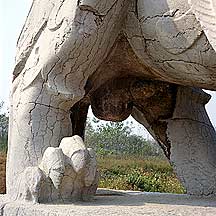
Details of its itchy claws.
-
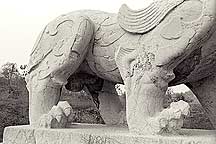
The body of the qilins are unusually decorative. One can see in qilin's defensive itchy paws the artists' careful observations.
-
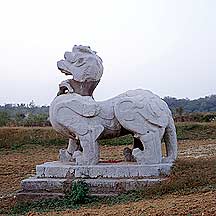
This is the single-horned qilin. When I was there, chillies were spread on its flat base for a sunbath.
-
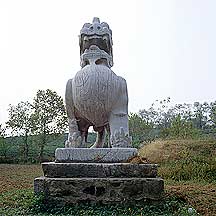
Qilins are said to be kind and generous. They would not tramp on grass nor prey. But this one has an effective mean look, suitable for it as a guardian of a royal tomb.
-
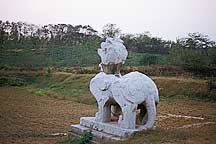
-
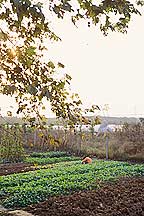
A girl doing farm work. Behind her is one of the lions.
-
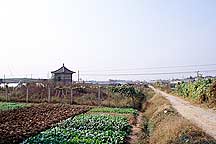
Road leading to one of the sets of lions.
-
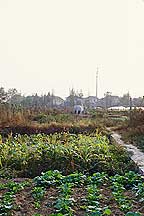
-
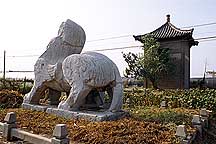
One of the Liang lions that form the spirit path for the eleventh son of the Liang ruller 梁文帝 Liang Wendi, who died in the year 522. The stone lion is 3.78 meter long and 2.92 meter high.
-
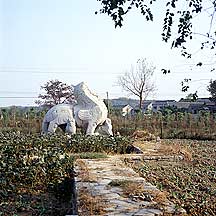
Stone path to the lion. The path leads to a stone square border surrounding the sculpture.
-
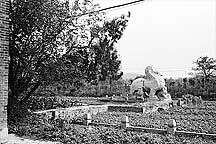
-
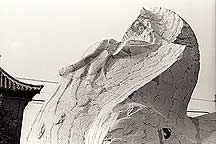
Someone or something knock off its menacing jaw.
-
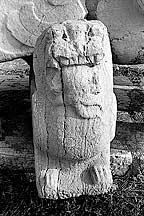
One of clubs under the belly of the jawless lion.
-
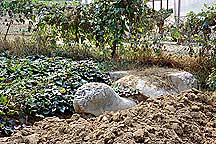
One of the two tortises that carry a stela on its back. This half-buried tortoise is released of the burden. Thoughout the 1600 years or so, the stone reptile must bave been buried and unearthed many times.
-
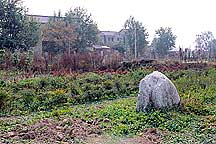
The only surviving chunk of the jawless lion's partner. It is 10 meter away in another fenced plot of land which I cannot get close to exam it.
-
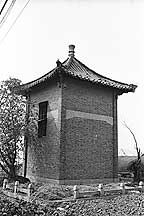
This is the brick shelter that housed the other tortoise with the intact stela. One of the side was opened but closed with a iron gate. I can see the pieces but impossible to photograph. The stela is a vertical slab of stone with carved memorative texts on its front flat surface. Two intricatively carved dragons rounded the top corners.
-
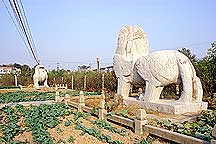
The other set of lions on the same area, about 30 meters away. These are smaller, about 1 meter high by 1.7 meter long.
-
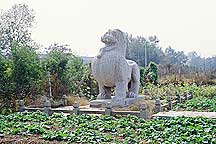
This pair of lions aren't very menacing. Their smaller scale and stiff stride as well as that awful white protective paint made them look like puppies.
-
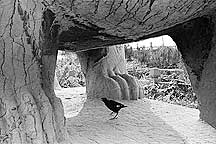
While hanging around the area, I met a man playing with his pet bird under one of the lions. My hair was about to light-up so I took cover under the shade of the beast rigbt next to the man. The man told me that he had been to Guangdong(where I am from) as a soldier. Now he is retired. He own two of these black birds. The luckless one took a bad turn and bang onto a coming vehicle. This one almost answer the same death wish by perching on live wire. As I sat there for the half hour or so, the little bird just jumped in and out of the platform erratically, hiding behing the legs and coming to my camera and gone in one swift motion. I like to grab its beak and give it a twist.
-
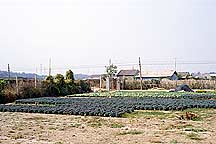
A view of the farm area.
